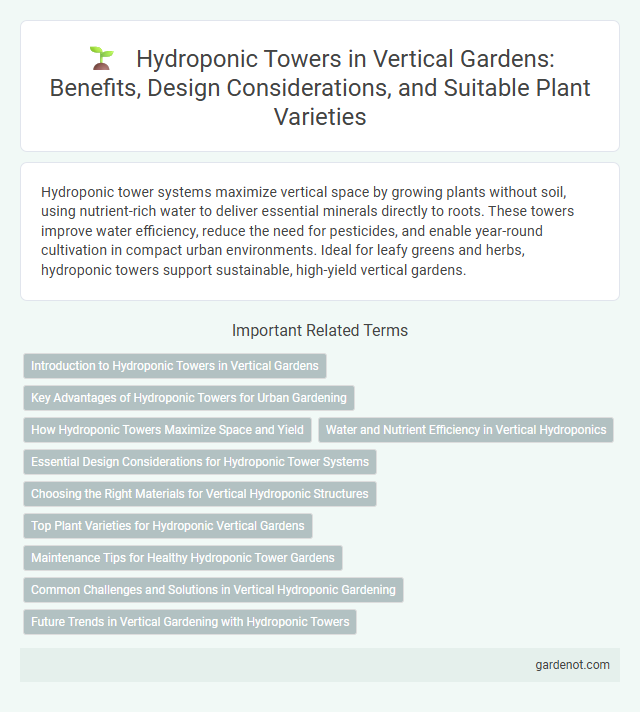Hydroponic tower systems maximize vertical space by growing plants without soil, using nutrient-rich water to deliver essential minerals directly to roots. These towers improve water efficiency, reduce the need for pesticides, and enable year-round cultivation in compact urban environments. Ideal for leafy greens and herbs, hydroponic towers support sustainable, high-yield vertical gardens.
Introduction to Hydroponic Towers in Vertical Gardens
Hydroponic towers revolutionize vertical gardening by enabling soil-free cultivation using nutrient-rich water solutions, maximizing space efficiency and plant growth. These towers support diverse plant species, including leafy greens, herbs, and strawberries, by delivering oxygen and nutrients directly to roots. With integrated systems for water recirculation and aeration, hydroponic towers significantly improve yield and sustainability in urban agriculture.
Key Advantages of Hydroponic Towers for Urban Gardening
Hydroponic towers maximize space efficiency by enabling vertical cultivation in limited urban environments, significantly increasing yield per square foot. These systems use nutrient-rich water solutions, reducing soil dependency and conserving water by up to 90% compared to traditional gardening. Maintenance is simplified with automated nutrient delivery and reduced pest issues, promoting sustainable, year-round urban gardening.
How Hydroponic Towers Maximize Space and Yield
Hydroponic towers maximize space by utilizing vertical layers to grow plants densely without soil, allowing for efficient use of limited areas such as balconies or small gardens. These towers optimize yield by providing precise nutrient delivery directly to the roots, promoting faster growth and healthier plants. Their modular design supports continuous planting and harvesting cycles, significantly increasing overall production within a compact footprint.
Water and Nutrient Efficiency in Vertical Hydroponics
Hydroponic towers in vertical gardens maximize water and nutrient efficiency by recirculating solutions through compact root zones, reducing waste and promoting faster plant growth. Precise control over nutrient delivery ensures optimal absorption, resulting in healthier plants and minimized resource consumption. This technology significantly lowers water usage compared to traditional soil gardening, making it ideal for sustainable urban agriculture.
Essential Design Considerations for Hydroponic Tower Systems
Hydroponic tower systems require careful attention to vertical space utilization, nutrient delivery efficiency, and water circulation to optimize plant growth in limited areas. Essential design considerations include selecting appropriate materials resistant to moisture, ensuring adequate light penetration for all plant levels, and incorporating a reliable irrigation system that minimizes water waste and supports consistent nutrient distribution. Proper aeration, ease of maintenance, and modular scalability also play critical roles in maximizing productivity and sustainability of hydroponic towers.
Choosing the Right Materials for Vertical Hydroponic Structures
Selecting durable, lightweight materials such as PVC, food-grade plastics, or galvanized steel is crucial for vertical hydroponic tower construction to ensure longevity and resistance to moisture. Materials with non-toxic properties and UV resistance enhance plant safety and structural stability in various environments. Prioritizing ease of cleaning and modular design supports efficient maintenance and scalability of vertical hydroponic systems.
Top Plant Varieties for Hydroponic Vertical Gardens
Lettuce, basil, and mint are among the top plant varieties thriving in hydroponic tower vertical gardens due to their rapid growth and compact root systems. Leafy greens like spinach and arugula also perform exceptionally well, benefiting from efficient nutrient delivery and space optimization in vertical setups. Strawberries and cherry tomatoes are popular fruiting plants in hydroponic towers, offering high yields and easy maintenance in vertical garden environments.
Maintenance Tips for Healthy Hydroponic Tower Gardens
Regularly check pH levels and nutrient concentrations to ensure optimal plant growth in hydroponic tower gardens. Clean the reservoir and components every two weeks to prevent algae buildup and blockages. Inspect pumps and tubing for leaks or damage to maintain a consistent water flow and nutrient delivery system.
Common Challenges and Solutions in Vertical Hydroponic Gardening
Vertical hydroponic gardens often face challenges such as nutrient imbalances, water distribution issues, and root crowding in hydroponic towers. Regular monitoring of pH levels, implementing automated drip irrigation systems, and spacing plants properly can mitigate these problems effectively. Employing disease-resistant plant varieties and maintaining proper aeration within the tower structure further enhances plant health and yield.
Future Trends in Vertical Gardening with Hydroponic Towers
Hydroponic towers represent a cutting-edge advancement in vertical gardening, maximizing space efficiency and resource conservation by using nutrient-rich water solutions instead of soil. Future trends indicate a surge in automation technology integrated with hydroponic towers, incorporating sensors and AI to optimize plant growth conditions and reduce human labor. Increasing urbanization and sustainability demands are driving widespread adoption of hydroponic vertical gardens in residential, commercial, and agricultural settings.
Hydroponic tower Infographic

 gardenot.com
gardenot.com